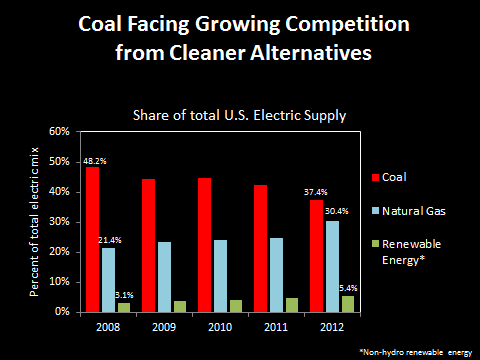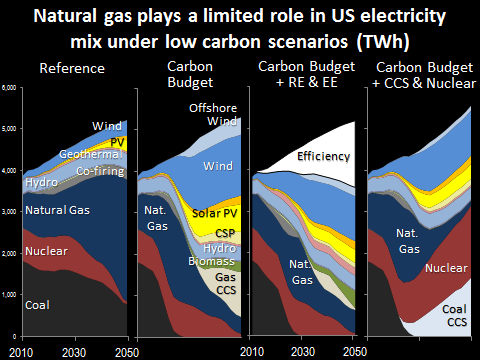The President’s climate plan is an important start for reducing carbon and other heat-trapping emissions from human activities that are driving climate change. One of the key components of his plan is directing the EPA to complete carbon standards for new and existing power plants, which could help transition the power sector away from coal to natural gas and other cleaner sources like renewable energy and energy efficiency.
 This post is part of a series on President Obama’s Climate Action Plan.
This post is part of a series on President Obama’s Climate Action Plan.
While natural gas has made an important contribution to reducing carbon and other harmful emissions from power plants in recent years, a recent UCS position paper on natural gas raises important questions around the long-term role of natural gas, as the U.S. and the rest of the world will eventually need to make much deeper cuts in global warming emissions. In addition, new research suggests that the leakage of methane (a potent global warming gas) during the extraction and distribution of natural gas may be undermining the potential to reduce these emissions.
And new horizontal drilling and hydraulic fracturing (or “fracking”) techniques, which have allowed domestic gas and oil production to expand rapidly over the past decade, have raised new questions about the impacts that natural gas extraction and use will have on climate change, public health and safety, land and water resources, and people. This expansion is currently outpacing our capacity to understand and manage the attendant risks.
Natural gas has made an important contribution to recent power sector carbon reductions
Over the past 5 years, coal’s share of the U.S. electricity mix has fallen from 48% to 37%, while natural gas and renewables (mostly wind and solar) have grown dramatically. These changes are due to a combination of market and policy factors including low natural gas prices, the rising cost of coal, compliance with new pollution standards to protect public health, the falling cost of renewable energy, and state and federal renewable energy policies

Source: EIA, Electric Power Monthly.
Because natural gas combined cycle power plants have 50-60 percent lower CO2 emissions per unit of electricity than a typical coal plant, and wind and solar have no CO2 emissions at all, this shift in the electricity mix reduced power plant CO2 emissions 16 percent below 2005 levels by the end of 2012 according to the Energy Information Administration (EIA) (see Table 12.6 on p. 165). This does not account for methane emissions from the switch to natural gas. Without additional policies such as the carbon standards for power plants, EIA projects power plant CO2 emissions to steadily increase through 2040, as natural gas and coal generation increase to meet the projected increase in electricity demand.

Much deeper cuts in carbon emissions are needed in the long term
Studies have shown that much deeper cuts in U.S. carbon emissions are needed to help limit some of the worst consequences of climate change. For example, a National Academies of Science (NAS) study found that the U.S. would need to adopt a cumulative economy-wide budget of 170 gigatons of CO2 equivalent by 2050 to have a reasonable chance of limiting global concentrations to 450 parts per million (ppm), assuming full participation by the rest of the world. This is consistent with the U.S. Copenhagen pledge of reducing emissions 17% below 2005 levels by 2020, in line with an eventual goal of 83% reductions by 2050. A large share of the emission reductions are likely to come from the electricity sector (as shown in the graph above), based on an analysis completed by the Stanford Energy Modeling Forum (EMF).
A recent peer-reviewed analysis by UCS and NREL shows that natural gas is likely to play a limited long-term role in meeting this carbon budget. Under three different U.S. electricity futures, natural gas generation increases before 2030 to replace retiring coal plants, but then declines significantly by 2050 to meet more stringent emission reduction targets. Under both a high renewables and efficiency scenario and a high nuclear and coal with CCS scenario, natural gas is used primarily to provide flexibility to the grid to help integrate wind and solar power and to meet peak electricity demand after 2030. However, under a carbon budget scenario without any targets for specific technologies, natural gas with carbon capture and storage (CCS) is projected to play a modest role near the end of the forecast. With up to $8 billion in loan guarantees for advanced fossil energy projects proposed in the President’s plan, some of this could be used to fund CCS demonstration projects with natural gas plants.

Source: Clemmer et al. 2013.
Recent studies by the International Energy Agency (IEA) have reached similar conclusions at the global level. For example, the IEA’s 2011 Golden Age of Natural Gas study found that a large global shift to natural gas would still put us on an emissions trajectory (based on energy-related CO2 emissions) toward a long-term global average temperature increase of more than 6°F–a level of warming associated with a high risk of catastrophic environmental and economic consequences. With the President’s plan also encouraging other countries to promote fuel switching from coal to natural gas and to develop natural gas in a responsible manner, an overreliance on natural gas could make it difficult for all countries to achieve long-term cuts in emissions.
Methane leakage from natural gas extraction and distribution must also be reduced
Smokestack emissions do not tell the full story. The drilling and extraction of natural gas from wells, and its transportation in pipelines, results in the leakage of methane, a far more potent global warming gas than CO2. Preliminary studies and field measurements show that these so-called “fugitive” methane emissions range from 1 to 9 percent of total life cycle emissions. While these methane leakage rates may sound small, studies show that methane losses must be kept below 2 to 3 percent for natural gas power plants to have lower life cycle emissions than coal (see references here).
To address this issue, the President’s plan calls for developing a comprehensive interagency strategy and collaborative approach to reduce methane emissions from natural gas production and distribution and other activities. EPA also finalized regulations in April 2012 that primarily target volatile organic compounds (VOCs) and air toxics emissions from natural gas systems including wellheads, but will have the co-benefit of reducing methane emissions. These new rules also require “green completions,” which will reduce methane emissions from hydraulic fracturing operations. Together, these new rules will reduce upstream methane emissions from natural gas production by an estimated 13% in 2015 and 25% by 2035, according to a recent WRI study.
While these are important steps, stronger federal regulations are needed to further reduce methane leakage from natural gas production and pipelines. WRI’s report shows that cost-effective technologies are commercially available today to reduce methane leakage rates to below 1% by 2020.
Where do we go from here?
Even if we could reduce fugitive methane emissions to zero, natural gas would still need to play only a limited role as a long-term climate solution because of its carbon emissions. Therefore, it’s important that the U.S. and other countries do not become over-reliant on natural gas in the short-term, given the long-lived nature of power plant investments. Adopting strong policies and programs to ensure the timely expansion of much lower and zero-carbon alternatives such as energy efficiency and renewable energy would go a long way in reducing this risk by diversifying our energy mix.
While the President’s plan for increasing efficiency and renewables is a step in this direction, we must go further. This includes allowing efficiency and renewables to be used for compliance with EPA’s power plant carbon standards. And to ensure that natural gas and other fossil fuels compete on a level playing field with these lower carbon alternatives, the United States should set limits that will reduce heat-trapping emissions at least 80 percent below 2005 levels by 2050, and put a price on carbon.
Better information and stronger regulations are also needed to understand and reduce the potential environmental and public health risks associated with fracking. This includes ensuring that federal and state regulation of the shale gas and oil industry works in a complementary and comprehensive fashion, and fast-tracking critical scientific research on the risks shale gas and oil extraction pose to people, communities, agriculture, and the environment.
